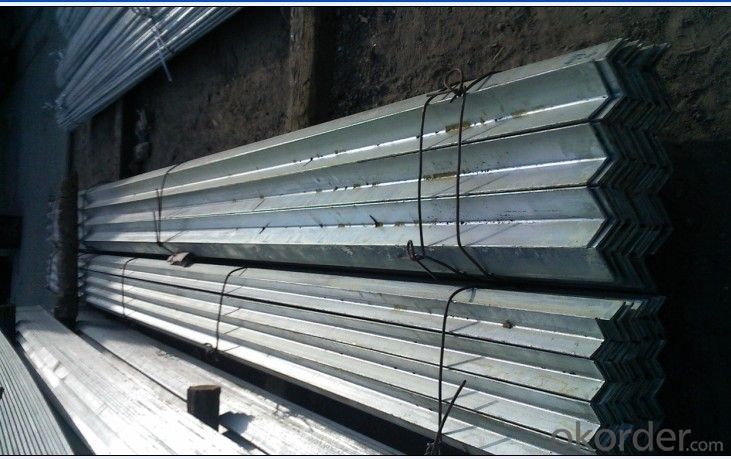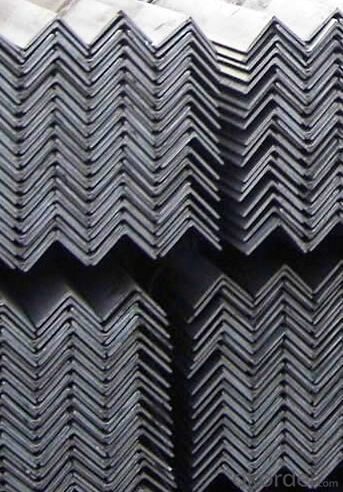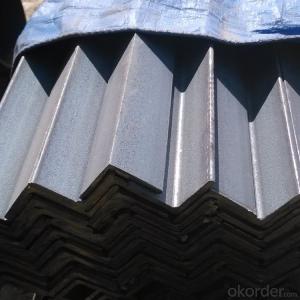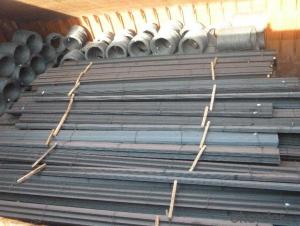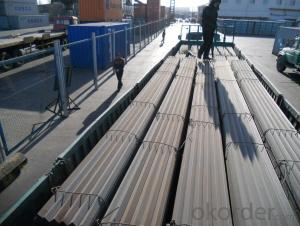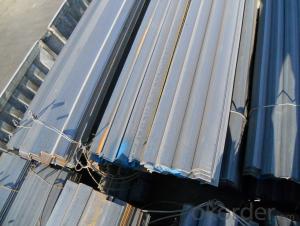Hot Rolled Steel Equal Angle Bar ASTM Standard
- Loading Port:
- Tianjin
- Payment Terms:
- TT or LC
- Min Order Qty:
- 50 m.t.
- Supply Capability:
- 20000 m.t./month
OKorder Service Pledge
OKorder Financial Service
You Might Also Like
OKorder is offering Hot Rolled Steel Equal Angle Bar ASTM Standard at great prices with worldwide shipping. Our supplier is a world-class manufacturer of steel, with our products utilized the world over. OKorder annually supplies products to African, South American and Asian markets. We provide quotations within 24 hours of receiving an inquiry and guarantee competitive prices.
Product Applications:
Hot Rolled Steel Equal Angle Bar ASTM Standard are ideal for structural applications and are widely used in the construction of buildings and bridges, and the manufacturing, petrochemical, and transportation industries
Product Advantages:
OKorder's Hot Rolled Steel Equal Angle Bar ASTM Standard are durable, strong, and wide variety of sizes.
Main Product Features:
· Premium quality
· Prompt delivery & seaworthy packing (30 days after receiving deposit)
· Can be recycled and reused
· Mill test certification
· Professional Service
· Competitive pricing
Product Specifications:
Manufacture: Hot rolled
Grade: Q195 – 235
Certificates: ISO, SGS, BV, CIQ
Length: 6m – 12m, as per customer request
Packaging: Export packing, nude packing, bundled
EQUAL ANGLES SIZES |
| ||
a(mm) | a1(mm) | thickness(mm) | length |
25 | 25 | 2.5---3.0 | 6M/12M |
30 | 30 | 2.5---4.0 | 6M/12M |
38 | 38 | 2.5 | 6M/12M |
38 | 38 | 3.0---5.0 | 6M/12M |
40 | 40 | 3.0---6.0 | 6M/12M |
50 | 50 | 3 | 6M/12M |
50 | 50 | 3.7---6.0 | 6M/9M/12M |
60 | 60 | 5.0---6.0 | 6M/9M/12M |
63 | 63 | 6.0---8.0 | 6M/9M/12M |
65 | 65 | 5.0---8.0 | 6M/9M/12M |
70 | 70 | 6.0---7.0 | 6M/9M/12M |
75 | 75 | 5.0---10.0 | 6M/9M/12M |
80 | 80 | 6.0---10.0 | 6M/9M/12M |
90 | 90 | 6.0---10.0 | 6M/9M/12M |
100 | 100 | 6.0---12.0 | 6M/9M/12M |
120 | 120 | 8.0-12.0 | 6M/9M/12M |
125 | 125 | 8.0---12.0 | 6M/9M/12M |
130 | 130 | 9.0-12.0 | 6M/9M/12M |
140 | 140 | 10.0-16.0 | 6M/9M/12M |
150 | 150 | 10---15 | 6M/9M/12M |
160 | 160 | 10---16 | 6M/9M/12M |
180 | 180 | 12---18 | 6M/9M/12M |
200 | 200 | 14---20 | 6M/9M/12M |
FAQ:
Q1: Why buy Materials & Equipment from OKorder.com?
A1: All products offered byOKorder.com are carefully selected from China's most reliable manufacturing enterprises. Through its ISO certifications, OKorder.com adheres to the highest standards and a commitment to supply chain safety and customer satisfaction.
Q2: How do we guarantee the quality of our products?
A2: We have established an advanced quality management system which conducts strict quality tests at every step, from raw materials to the final product. At the same time, we provide extensive follow-up service assurances as required.
Q3: How soon can we receive the product after purchase?
A3: Within three days of placing an order, we will arrange production. The normal sizes with the normal grade can be produced within one month. The specific shipping date is dependent upon international and government factors, the delivery to international main port about 45-60days.
Images:
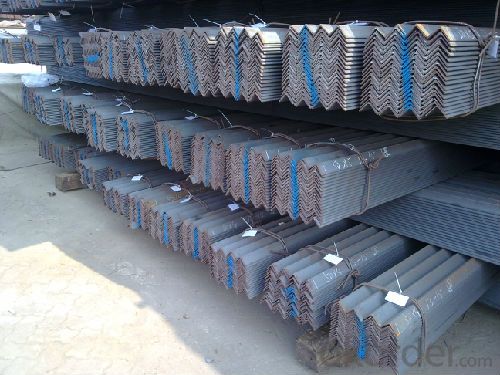
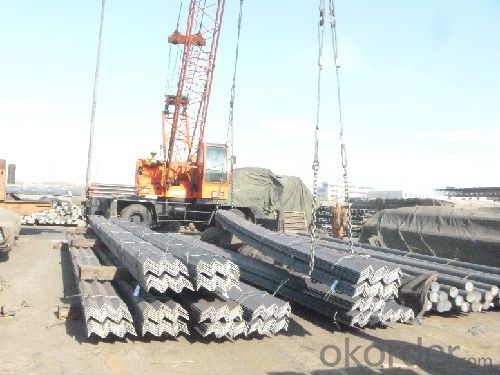
- Q: How do you connect steel angles together?
- There are several ways to connect steel angles together depending on the specific application and load requirements. Here are a few common methods: 1. Welding: The most common and effective method is to weld the steel angles together. This creates a strong and permanent connection. It is important to ensure proper welding techniques are followed to maintain the integrity and strength of the joint. 2. Bolting: Another method is to use bolts and nuts to connect the steel angles. This allows for easy disassembly and reassembly if required. It is important to use the correct size and grade of bolts to ensure the connection can withstand the intended loads. 3. Riveting: Rivets can also be used to connect steel angles together. This method provides a strong and permanent connection, but it requires specialized tools and expertise to properly install the rivets. 4. Adhesive bonding: In some cases, adhesive bonding techniques can be used to connect steel angles together. This method is usually used in conjunction with other fastening methods, such as welding or bolting, to provide additional strength and stability. When choosing the method to connect steel angles, it is important to consider factors such as the load requirements, environmental conditions, and expected lifespan of the structure. Consulting with a structural engineer or a professional in the field is recommended to ensure the best connection method is chosen for your specific application.
- Q: How do you prevent corrosion between steel angles and other materials?
- There are several effective measures that can be taken to prevent corrosion between steel angles and other materials: 1. To create a barrier between the steel and surrounding materials, protective coatings such as paint, epoxy, or galvanization can be applied. This prevents direct contact and reduces the risk of corrosion. 2. Insulating materials like rubber or plastic pads or sleeves can be used to separate the steel angles from other materials. This prevents direct contact and minimizes the chances of corrosion. 3. A cathodic protection mechanism can be established by installing sacrificial anodes or using impressed current systems. This creates an electrical current that counteracts the corrosion process, protecting the steel angles. 4. Regular inspection and maintenance of the steel angles are crucial to promptly identify any signs of corrosion and take appropriate actions. This includes cleaning the surfaces, repairing damaged coatings, and replacing corroded parts. 5. Proper drainage is essential to prevent moisture accumulation around the steel angles, which can accelerate corrosion. Designing and installing drainage systems correctly can prevent water or corrosive substances from pooling around the steel angles. 6. If the steel angles are exposed to chemicals or corrosive substances, it is important to choose materials that are resistant to corrosion. This may involve using stainless steel or other corrosion-resistant alloys to withstand exposure to specific chemicals. By implementing a combination of protective coatings, insulation, cathodic protection, regular maintenance, proper drainage, and material selection, corrosion between steel angles and other materials can be effectively prevented. This ensures the longevity and structural integrity of the steel angles.
- Q: What are the guidelines for designing connections using steel angles?
- When designing connections using steel angles, there are several guidelines that should be followed to ensure structural integrity and safety. Here are some key considerations: 1. Load capacity: Determine the maximum load that the connection will be subjected to. This includes both axial and shear loads. Ensure that the selected angle size and thickness can support these loads without failure. 2. Angle selection: Choose an appropriate size and shape of the steel angle based on the required load capacity. Common angle sizes include L-shaped angles and T-shaped angles. Consider the material grade as well to ensure it meets the required strength specifications. 3. Welding: Welding is commonly used to connect steel angles. Ensure that proper welding techniques are followed, and the welds are of high quality. The strength of the weld should be at least equal to the strength of the angles being connected. 4. Bolting: Bolting can also be used for connections. Select appropriate bolts, nuts, and washers that meet the required strength and corrosion resistance. Follow the recommended bolt tightening procedures to achieve the desired clamping force. 5. Connection details: Consider the type of connection required, such as moment connections, shear connections, or bracing connections. Each type has specific design requirements and detailing considerations. Follow industry standards and codes to ensure the connection is designed properly. 6. Clearances: Provide sufficient clearances between connected members to allow for easy fabrication and construction. Ensure that there is enough space for welding, bolting, and necessary inspections. 7. Corrosion protection: Consider the potential for corrosion in the connection design. Apply appropriate coatings, such as paint or galvanizing, to protect the steel angles from rusting and deterioration over time. 8. Design checks: Perform structural analysis and design checks to verify the adequacy of the connection design. This may include checking for stress concentrations, deflections, and stability requirements. 9. Fabrication and inspection: Ensure that the fabrication and construction of the connection are carried out according to the design specifications. Regularly inspect the connections during fabrication and construction to ensure compliance with the design requirements. By following these guidelines, designers can create safe and reliable steel angle connections that meet the required load capacity and structural integrity for various applications.
- Q: How do steel angles contribute to the overall aesthetic of a structure?
- Steel angles can contribute to the overall aesthetic of a structure in several ways. Firstly, their clean and sleek lines can add a modern and contemporary look to the design. The sharp edges and precise angles of steel angles can create a sense of strength and solidity, giving the structure a bold and industrial feel. Additionally, steel angles can be used to create interesting and dynamic shapes within the architecture. Their versatility allows for unique and eye-catching designs, such as cantilevered balconies or intricate lattice patterns. These visually appealing features can become focal points of the structure and enhance its overall aesthetic appeal. Moreover, steel angles can be used to create a sense of rhythm and repetition in the design. By incorporating them in a consistent pattern or arrangement, they can create a visual harmony and balance. This repetition can be particularly effective in large-scale structures, where the steel angles can help break up the monotony of the façade and add visual interest. Furthermore, steel angles can also contribute to the overall durability and longevity of the structure, which in turn enhances its aesthetic value. Steel is known for its strength and resilience, and when used in angles, it can provide structural support and stability. This durability can ensure that the structure remains visually appealing for years to come, without compromising on safety or integrity. Overall, steel angles play a significant role in the aesthetic of a structure, adding a sense of modernity, strength, and versatility. Their clean lines, dynamic shapes, and durability can all contribute to creating a visually appealing and impactful architectural design.
- Q: Can steel angles be used for solar panel installations?
- Indeed, steel angles are suitable for the installation of solar panels. Solar panels receive structural support and stability through the utilization of steel angles, whether they are affixed to rooftops or other structures. These angles are frequently employed to construct a framework or mounting system, ensuring the secure placement of the panels. Demonstrating strength and durability, steel angles possess the capability to endure the weight of the panels and any additional external forces, such as wind or snow loads. Moreover, steel angles can be conveniently fabricated and personalized to meet precise installation prerequisites, thus rendering them a versatile option for solar panel installations.
- Q: How do steel angles perform in high-vibration environments?
- Due to their exceptional structural strength and stability, steel angles are a perfect match for high-vibration environments. Steel's inherent properties, such as its impressive tensile strength and rigidity, enable steel angles to endure dynamic loads and vibrations without compromising their structural integrity. In machinery, construction, and transportation, where vibrations are prevalent, steel angles are widely used. The performance of steel angles in high-vibration environments is also attributed to their L-shaped cross-section design. This configuration provides additional support and resistance against bending and torsional forces, making steel angles more resistant to vibrations compared to other materials. This design feature effectively minimizes the risk of deformation or fatigue that could arise from constant vibrational stress. Furthermore, steel angles can be further reinforced to withstand high-vibration environments through surface treatments and coatings. Techniques such as galvanization or painting can be employed to apply a protective layer that enhances corrosion resistance and prevents the degradation of the steel's mechanical properties. This added protection ensures the long-lasting durability of steel angles in challenging environments. To summarize, steel angles are the perfect choice for high-vibration environments due to their robust nature, L-shaped design, and potential for surface treatments. Their ability to withstand dynamic loads, resist bending and torsional forces, and maintain structural integrity make them dependable and efficient components in various industries where vibration is a concern.
- Q: How do you prevent rust on steel angles?
- To prevent rust on steel angles, there are several steps you can take: 1. Apply a protective coating: One of the most effective ways to prevent rust is to apply a protective coating on the steel angles. This can be done using paint, varnish, or other corrosion-resistant coatings. Make sure to choose a coating that is specifically designed for preventing rust on steel surfaces. 2. Use galvanized steel angles: Galvanization is a process where a layer of zinc is applied to the steel, providing a protective barrier against rust. Using galvanized steel angles can significantly reduce the risk of rust formation. These angles are readily available in the market and are a popular choice for outdoor applications. 3. Keep moisture away: Rust formation is accelerated by moisture, so it is crucial to keep steel angles dry. Avoid exposing them to rain, humid environments, or excessive moisture. If the angles are installed outdoors, ensure proper drainage and provide adequate ventilation to prevent the buildup of moisture. 4. Regular cleaning and maintenance: Regularly cleaning the steel angles will help remove any dirt, dust, or other contaminants that can contribute to rust formation. Use a mild detergent or cleaning solution and a soft cloth or sponge to clean the surface. After cleaning, make sure the angles are completely dry before applying any protective coating. 5. Monitor and repair damaged coatings: Over time, protective coatings may get damaged due to wear and tear or exposure to harsh conditions. It is essential to monitor the condition of the coatings and repair any damaged areas promptly. This will help maintain the integrity of the protective layer and prevent rust from forming. 6. Consider using stainless steel angles: Stainless steel is highly resistant to rust and corrosion due to its chromium content. If rust prevention is a top priority, you may consider using stainless steel angles instead of regular steel. Although stainless steel angles are typically more expensive, they offer superior durability and a longer lifespan. By implementing these preventive measures, you can significantly reduce the risk of rust formation on steel angles, ensuring their longevity and maintaining their structural integrity.
- Q: How do steel angles perform in terms of sound reflection or absorption?
- Steel angles are typically used in construction and engineering applications where their primary purpose is to provide structural support and stability. In terms of sound reflection or absorption, steel angles do not have any significant effect. Due to their dense and rigid nature, steel angles tend to reflect sound rather than absorb it. This means that when sound waves encounter a steel angle, they bounce off its surface and continue to propagate in the surrounding environment. As a result, steel angles are not generally relied upon for soundproofing purposes. To effectively control sound reflection or absorption, alternative materials with sound-dampening properties, such as acoustic panels, insulation, or specialized soundproofing materials, are typically used. These materials are designed to absorb sound waves and minimize their reflection, resulting in a quieter and more controlled acoustic environment. In summary, steel angles are not effective in terms of sound reflection or absorption due to their rigid and reflective nature. Alternative materials should be considered for soundproofing purposes in order to achieve the desired acoustic performance.
- Q: How do you calculate the torsional strength of a steel angle?
- To calculate the torsional strength of a steel angle, several factors need to be taken into consideration. Firstly, it is important to determine the moment of inertia of the cross-section of the steel angle. This can be done by using the formula for the moment of inertia of a rectangular shape, which is (b * h^3)/12, where b is the base width and h is the height of the angle. Once the moment of inertia is determined, the maximum shear stress can be calculated using the formula T = (M * c)/I, where T is the torsional strength, M is the applied torque, c is the distance from the centroid of the angle to the outermost fiber, and I is the moment of inertia. The maximum allowable shear stress for the steel angle can be determined based on the material properties of the steel. This value can be obtained from engineering handbooks or specifications. Finally, the torsional strength of the steel angle can be calculated by multiplying the maximum allowable shear stress by the moment of inertia of the angle. It is important to note that this calculation assumes the steel angle is subjected to pure torsion without any bending or other external loads. If the angle is subjected to combined loads, more complex calculations may be required to determine the torsional strength.
- Q: What is the typical length of a steel angle?
- Steel angles can have varying lengths depending on their purpose and application. Generally, a steel angle is commonly found at a length of 20 feet or 6 meters. This standard length facilitates convenient handling, transportation, and installation in diverse construction and fabrication projects. Nevertheless, it is important to acknowledge that steel angles can be tailored or trimmed to shorter lengths in order to meet specific requirements or accommodate specific designs.
Send your message to us
Hot Rolled Steel Equal Angle Bar ASTM Standard
- Loading Port:
- Tianjin
- Payment Terms:
- TT or LC
- Min Order Qty:
- 50 m.t.
- Supply Capability:
- 20000 m.t./month
OKorder Service Pledge
OKorder Financial Service
Similar products
Hot products
Hot Searches
Related keywords



